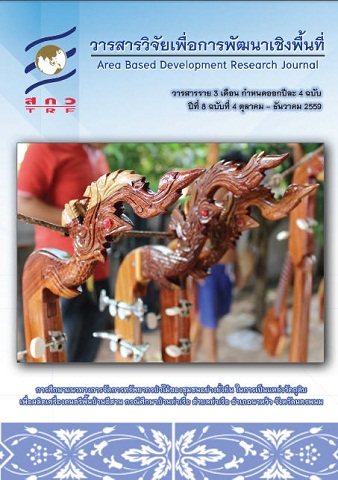การศึกษาแนวทางการจัดการทรัพยากรป่าไม้ของชุมชนอย่างยั่งยืนในการเป็นแหล่งวัตถุดิบเพื่อผลิตเครื่องดนตรีพื้นบ้านอีสาน กรณีศึกษาบ้านท่าเรือ ตำบลท่าเรือ อำเภอนาหว้า จังหวัดนครพนม
Main Article Content
Abstract
ชุมชนบ้านท่าเรือ ตําบลท่าเรือ อําเภอนาหว้า จังหวัดนครพนม เป็นชุมชนที่ผลิตเครื่องดนตรีพื้นบ้านแหล่งสําคัญแห่งหนึ่งในภาคอีสาน ที่สร้างรายได้ให้กับคนในชุมชนและเป็นที่รู้จักกันอย่างแพร่หลายไปทั่วประเทศ ในปัจจุบันบ้านท่าเรือกําลังประสบกับภาวะวิกฤตในการขาดแคลนไม้วัตถุดิบในการทําเครื่องดนตรี เนื่องจากป่าไม้ในหมู่บ้านที่เป็นแหล่งวัตถุดิบสําคัญร่อยหรอ ด้วยเหตุดังกล่าว โครงการวิจัยนี้จึงมีวัตถุประสงค์เพื่อ 1) ทบทวนถึงปัญหาเรื่องการจัดการผลผลิตจากป่าที่ใช้เป็นวัตถุดิบในการผลิตเครื่องดนตรีพื้นเมือง และ 2) หาแนวทางในการจัดการทรัพยากรป่าไม้ในชุมชนอย่างยั่งยืน โดยใช้วิธีวิจัยเชิงปฏิบัติการแบบมีส่วนร่วม (Participatory action research หรือ PAR) เก็บข้อมูลร่วมกับนักวิจัยชาวบ้านด้วยเครื่องมือต่างๆ เช่น การสัมภาษณ์แบบเจาะลึก การสนทนากลุ่มย่อย และการจัดเวทีชาวบ้านเพื่อระดมความคิดเห็นร่วมกัน โดยมีกลุ่มเป้าหมาย ได้แก่ กลุ่มผู้ผลิตและกลุ่มผู้ค้าเครื่องดนตรี กลุ่มชาวบ้านที่มีความเชี่ยวชาญในเรื่องเครื่องดนตรีและพรรณไม้พื้นเมือง และกลุ่มผู้นําชุมชน ผลการวิจัย พบว่า พัฒนาการของการใช้ประโยชน์จากป่าไม้ในชุมชนบ้านท่าเรือแบ่งเป็น 2 ช่วงเวลา คือ ช่วงแรก สมัยการผลิตแคนในระยะเริ่มแรก พ.ศ. 2470 - 2499 เป็นช่วงที่ชาวบ้านใช้วัตถุดิบส่วนใหญ่ที่มีอยู่ในชุมชนในการทําแคน มีวิธีการจัดการป่าชุมชนภายใต้คติความเชื่อเรื่องผีปู่ตาและกลไกในระบบเครือญาติ ช่วงที่สอง สมัยการขยายตัวของการผลิตแคนและเครื่องดนตรีชนิดอื่น พ.ศ. 2500 - 2557 ช่วงนี้เป็นการผลิตเพื่อส่งออกยังตลาดภายนอก มีการนําเข้าไม้ที่เป็นวัตถุดิบจากประเทศลาวและจังหวัดใกล้เคียง โดยชาวบ้านได้จัดการป่าไม้และวัตถุดิบในการทําเครื่องดนตรีผ่านองค์กรชุมชน สําหรับแนวทางการบริหารจัดการป่าไม้ชุมชนเพื่อให้เกิดความยั่งยืนนั้น ได้ขับเคลื่อนด้วยการหาวิธีการขยายพันธุ์ไม้ไผ่ลูกแคน เพื่อปลูกชดเชยพื้นที่ป่าในชุมชนและเพื่อทดแทนการนําเข้าจากภายนอก รวมถึงการสนับสนุนให้เกิดการท่องเที่ยวเชิงอนุรักษ์ที่ป่าปู่ตา เพื่อเผยแพร่ให้ความรู้เกี่ยวกับพันธุ์ไม้ในป่า อันเป็นการเสริมพลังเพื่อสร้างจิตสํานึกและการตระหนักรู้เห็นความสําคัญของป่าชุมชน
Sustainable Management of Community Forest as Material Site for Producing Isan Folk Music Instruments: Case Study of Tha Ruea Village, Tha Ruea Sub District, Na Wa District, Nakhon Phanom Province
Tha Ruea Village, Tha Ruea sub District, Na Wa District, Nakhon Phanom Province, was a well-known community in the northeastern region as an important site of manufacturing Isan folk music instruments. Nowadays, however, Tha Ruea Village encounters a crisis of wood materials for manufacturing Isan folk music instruments because community forest as the main material site was becoming depleted. The objectives of this research project are 1) to contemplate circumstance of problems toward community forest management for manufacturing Isan folk music instruments. 2) to study and find out a sustainable management approach of community forest as a material site for manufacturing Isan folk music instruments. Participatory action research (PAR) was the heart of research process and research tools used in this research were an in-depth interview, a focus group discussion and especially, the community forum organized villagers and researchers for running a brainstorming. The research participants and representative samples consisted of manufacturer and dealer group, local intellectual and expert group and community leader group.
The findings showed that development and usage of Tha Ruea’s community forest could be divided into two stages. In the first stage or the early Isan folk music instruments manufactures (1927-1956), the major materials for manufacturing Isan folk music instruments were taken from the community forest managed by using belief of guardian sprit and kinship system as the main supporting and controlling mechanism. The second stage or the expansion of Isan folk music instruments manufactures (1957-2014) revealed the rapid growth of Isan folk music instruments manufacture as the exported products. In this period, the major materials for manufacturing Isan folk music instruments were taken from Lao People’s Democratic Republic and its periphery. Community organizations were used as the main mechanism of community forest management.
The approaches of sustainable management of community forest as material sites for manufacturing Isan folk music instruments taken from this research were to find out techniques of material plant breeding for increasing community forest area and reducing imported materials from outside community. Ecotourism of community forest was also an alternative tool for supporting of learning process of local plants as well as empowering of villagers through consciousness-raising toward community forest.
Article Details
Area Based Development Research Journal values copyright protection and licensing to safeguard author rights and facilitate the appropriate dissemination of research. Our policies ensure openness, accessibility, and attribution. Authors retain copyright ownership, and articles are published under a Creative Commons Attribution License (CC BY), allowing sharing, adaptation, and proper attribution. Authors have the freedom to publish under the CC BY license, granting broad reuse and distribution permissions. The journal supports posting articles on third-party repositories, adhering to institutional and funding restrictions. Author guidelines detail copyright and licensing requirements, empowering authors with knowledge about their rights and responsibilities. These policies cultivate an environment of collaboration, openness, and responsible sharing, benefiting authors and the research community while honoring intellectual property rights.


